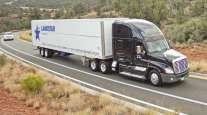Trucking Firms to Report Higher 3rd-Quarter Profit
This story appears in the Oct. 18 print edition of Transport Topics.
Nearly all publicly traded trucking companies will report third-quarter profits that exceed their results from a year earlier and the previous three months, analysts said.
Industry analysts attributed the expected profit growth to factors such as higher freight rates and more efficient fleet operations, rather than strong tonnage growth. Indicators such as American Trucking Associations’ tonnage index showed slowing tonnage year-to-year growth through the summer.
“The [third] quarter was good, but not blow-off-the-doors great,” said Jeff Kauffman, an analyst at Sterne, Agee & Leach Inc. “We are still growing, but the rate of growth is kicking down noticeably.” However, he said, “this is a deceleration; it is not a contraction.”
Based on a Transport Topics review of earnings per-share estimates of 21 fleets, published by Bloomberg News, 19 will report year-over-year growth, and at least 17 should boost results from second-quarter levels.
Third-quarter results will build on the trend of carrier profit improvement that also occurred in the second quarter, when a similar number of fleets also increased earnings, both year-over-year and month-to-month.
As of Oct. 14, one truckload carrier, Landstar System, had reported results. Its third-quarter profit, excluding an acquisition-related one-time charge, was $24.2 million, or 49 cents a share, matching per-share results for its previous quarter. Second-quarter 2010 earnings were $24.4 million.
Landstar’s latest profit rose 20% from third-quarter 2009 earnings of $20.1 million, or 39 cents a share. Revenue increased 24% to $622.8 million, reflecting 10% shipment growth and 14% higher rates.
On a year-to-year basis, Covenant Transportation Group Inc., P.A.M. Transportation Services Inc. and USA Truck Inc. are expected to convert losses in the year-ago quarter into profits, which they also did in the second quarter. However, profits at Covenant and P.A.M. aren’t expected to match second-quarter 2010 performance.
Covenant is expected to slip to 16 cents a share in the third quarter from 20 cents a share in the second quarter. P.A.M. is expected to drop to 8 cents a share from 13 cents a share.
The only other company that is expected to do worse in the third quarter than the second quarter of 2010 is YRC Worldwide Inc.
YRC is expected to lose $1.28 a share, reflecting a recent reverse stock split. In the third quarter last year, the carrier lost $158.7 million, and it lost $9.5 million in the second quarter this year.
Every company except Con-way Inc. and Saia Inc. is expected to post better year-over-year profits.
Con-way’s earnings, hurt by lower rates and higher costs, are expected to fall to 25 cents a share from 39 cents a share a year earlier, when earnings were $19.3 million, excluding charges. Saia’s 2009 third-quarter profit of $3.3 million, or 24 cents a share, inflated by a change in vacation cost calculations, is pegged to drop to 15 cents a share.
Ed Wolfe of Wolfe Research said he expected truckload yields, measured in rates per mile excluding fuel surcharge, to rise 3.3% from the third quarter of 2009 and 1.6% from the second quarter, driven by contract pricing increases.
Kauffman said he expects profit margins, rates and utilization of equipment will improve in the third quarter from second-quarter levels, but the rate of year-to-year improvement will moderate to a range of about 7% to 9%, from more than 10%.
Stifel, Nicolaus & Co. analyst John Larkin agreed that rates are rising.
“Many shippers are beginning to realize that safety regulations, combined with a modestly growing economy, are likely to drive severe capacity shortages in coming years and accordingly are beginning to budget for higher rates” that will start to show up in the third quarter, he said in a report. “Year-over-year unit revenue increases should be evident in the third quarter of 2010.”
Larkin attributed the strength to “rising spot and contract rates, better freight selection, reduced use of brokers and reduced empty miles.”
Dahlman Rose & Co. analyst Jason Seidl said in an investor report that “business was strong in the second quarter, followed by a largely flat third quarter. During the second quarter, the strength in business activity was seen in April and May and tailed off into a more flattish range in June. That continued into the third quarter of 2010.”
He based the report on comments by three privately held trucking companies — Cowan Systems LLC, Melton Truck Lines Inc. and First Express Inc. — which participated in a recent conference call.
Wolfe also saw another truckload trend emerging.
“We are starting to sense an inflection where large truckload fleets are beginning to take [market] share again from smaller carriers who are facing credit and financing issues, leading to aging equipment and worsening service.”
The less-than-truckload picture is also improving, Wolfe said.
“Although still weak, LTL pricing appears to be stabilizing, and it is our sense that the LTLs are likely to report positive year-over-year yields,” Wolfe said. “This would mark the first quarter of improved year-over-year yields for the group since the second quarter of 2008.”




